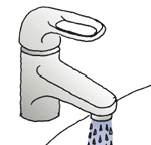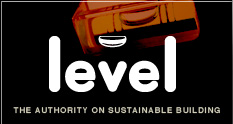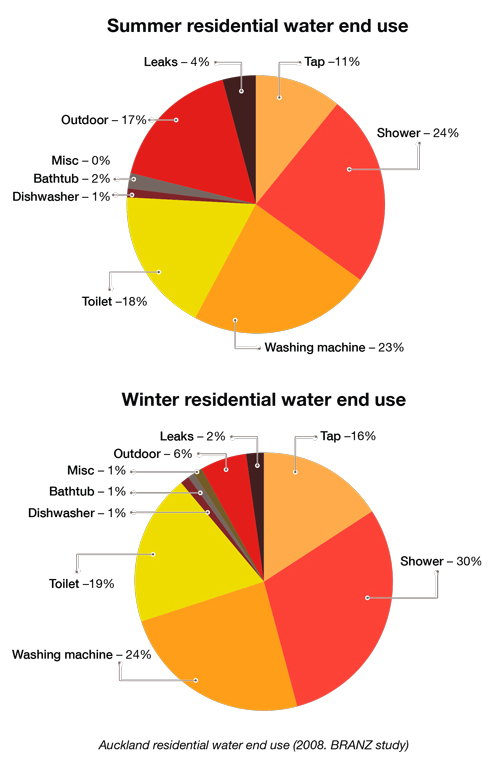Water
Water use, sustainability, and efficiency by choosing quality systems and materials, and providing environmentally friendly solutions.
Appliances and fixtures
Efficient appliances and fixtures can significantly reduce water use.
On this page:
- Household water use
- Toilets
- Fixtures
- Appliances.
Household water use
BRANZ monitored 51 random houses in Auckland and found that showers, washing machines and toilets account for almost three quarters of the water used. It makes sense therefore to focus on these three areas for potential water savings.
Toilets
In an average home, around one litre in five is used for toilet flushing. This can be reduced by:
- ensuring a dual flush cistern is specified
- installing a water-efficient toilet pan
- using collected rainwater or treated greywater for flushing
- installing waterless composting toilets where no mains sewer connection is available.
Many older cisterns use far more water than necessary – up to 12 litres is not uncommon. To reduce the amount of water used, replace the inefficient cistern with a modern dual-flush one that uses 6 / 3 litres or 4.5 / 3 litres. (A new pan may be needed where a dual flush cistern cannot be fitted to the existing one.)
Toilets are covered by the New Zealand Water Efficiency Labelling Scheme, and must have efficiency labels on them – see Appliances below.
If fitting a new pan/cistern is impractical, options you can use to reduce water usage include:
- placing an object such as a brick, or plastic milk bottle filled with water that has the top firmly screwed on into the cistern to reduce the amount of water required to fill an older cistern
- adjusting the float ball by bending it down slightly to reduce the volume of water in the cistern – ensure that sufficient flow and volume is maintained for an adequate flush
- ensuring that the cistern supply shuts off fully when not in use.
In all cases, sufficient flow and volume must be maintained so the pan is cleared with a single flush.
Other fixtures
Water usage can be reduced by specifying/installing:
- For main-pressure systems, low-flow showerheads that use less than 9 litres of water per minute and still deliver a comfortable shower
- aerators on taps used for hand washing. These relatively inexpensive devices reduce water flow from around 18–28 litres per minute to 6, 8 or 12 litres per minute. Aerators are not suitable for taps on baths where a larger volume of water is required.

- Reduced water flow by specifying an aerator
An aerator on a tap used for handwashing will reduce the flow while still providing plenty of water. Aerators should not be specified for taps on fixtures such as baths where a large volume of water is required.
Appliances
Reduce water use by recommending water-efficient appliances. Under the Water Efficiency Labeling Scheme (WELS), certain products must display a WELS label. These include:
- clothes washing machines
- dishwashers
- lavatories
- showers
- taps.
The WELS label shows a star rating for relative water efficiency – the more stars, the better, up to a maximum of 6 (currently 4 for showers) – and a water consumption or water flow figure. The latter is given in:
- litres per minute (showers and taps)
- litres per wash (clothes washing machines and dishwashers)
- llitres per half flush, full flush, and average flush – the average of four half flushes and one full flush (for lavatories).
Information about water efficiency can also be found at the Australian water efficiency rating scheme website www.waterrating.gov.au.
Do not specify or install waste disposal units. Instead, where possible, encourage building users to compost all organic kitchen waste.
Updated: 25 July 2022


